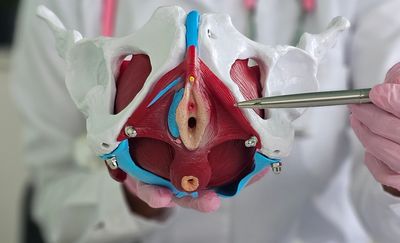Pelvic Floor Acupuncture Los Angeles, Santa Monica, pelvic pain, erectile dysfunction, urinary incontinence, prolapse, pudendal neuralgia

Supporting Core Health from the Inside Out
Your pelvic floor is the foundation of your body’s core and consists of a network of muscles, fascia, and nerves that supports your bladder, bowel, and reproductive organs. When it becomes tense, weak, or uncoordinated, it can affect everything from posture to digestion, pain, and sexual function.
Pelvic floor acupuncture is a specialized approach that gently restores balance, circulation, and communication within this vital area.
How It Works
Acupuncture helps by:
- Relaxing overactive muscles
- Increasing local blood flow and oxygenation
- Calming irritated nerves
- Restoring normal tone and coordination between the pelvic floor and diaphragm
- Engaging the body’s natural pain-modulating pathways
What Pelvic Floor Acupuncture Can Treat
Pelvic floor acupuncture supports a wide range of conditions involving the pelvic, abdominal, and lower back regions. Because the pelvic floor connects to nearly every major muscle group involved in posture, breathing, and core stability, restoring balance here can improve both localized and referred pain patterns.
Common Conditions Treated
- Pelvic pain syndromes: Chronic pelvic pain, pudendal neuralgia, levator ani syndrome, vulvodynia and pelvic floor myalgia.
- Lower back pain: Especially pain that persists despite spinal or muscular therapy, or pain linked to pelvic imbalance.
- Hip, groin, and tailbone pain: Including sacroiliac joint dysfunction, coccydynia, and gluteal or piriformis tension.
- Urinary issues: Bladder pain syndrome, Urgency, frequency, incontinence, incomplete emptying, and post-partum bladder changes.
- Bowel dysfunction: Constipation, Fecal incontinence, straining, or pelvic outlet obstruction due to muscle hypertonicity or incoordination.
- Prolapses: Anterior prolapse (bladder prolapse or cystocele), posterior prolapse (rectal prolapse or rectocele), and apical prolapse (uterine prolapse or vault prolapse).
- Sexual pain and dysfunction: Dyspareunia (painful intercourse), vaginismus, erectile dysfunction, hard/flaccid syndrome, Peyronies, or pelvic tension following trauma or surgery.
- Postpartum recovery: Support for muscle re-coordination, scar tissue healing, and pelvic stability after childbirth.
- Menstrual and reproductive health: Dysmenorrhea, endometriosis-related pain, pelvic congestion, or pelvic floor tension associated with hormonal changes.
- Athletic performance and injury recovery: For runners, cyclists, and athletes with hip or core instability, hamstring tightness, or recurrent “mystery” injuries linked to pelvic asymmetry.
- Stress and nervous system regulation: Because the pelvic diaphragm works in concert with the respiratory diaphragm, treatment can reduce sympathetic overactivity and promote parasympathetic (restorative) balance.
- Restoring normal tone and coordination between the pelvic floor and diaphragm
- Engaging the body’s natural pain-modulating pathways
What to Expect
Your first visit begins with a detailed discussion of your symptoms, medical history, and comfort level.
Sessions may combine:
- Surface acupuncture points on the abdomen, back, hips, or legs
- External pelvic floor needling
- Electroacupuncture
- Breathing, relaxation, or somatic awareness techniques
You remain draped and supported at all times for privacy and safety.
You may bring a chaperone to be in the room with you, if it would make you feel more comfortable.
For All Genders and Life Stages
Pelvic floor dysfunction affects women, men, and all gender identities; yet it’s often under-recognized and under-treated.
Whether you are recovering postpartum, experiencing chronic pelvic pain, or addressing urinary or sexual health concerns, pelvic floor acupuncture offers a safe, holistic way to reconnect with your body and regain confidence in your core.
Is It Right for You?
Pelvic floor acupuncture can be safely combined with:
- Physical therapy
- Pelvic floor exercises
- Traditional acupuncture
- Hormonal or pain management care
Your practitioner will help design a plan that fits your unique needs and comfort level.
Looking Beyond the Lower Back
Chronic lower back pain often persists despite conventional therapies such as massage, chiropractic adjustments, or physical therapy. One key reason is that treatment frequently targets the location of pain rather than the underlying source of dysfunction.
The musculature that stabilizes the lumbar spine does not end at the back, it integrates directly with the pelvic girdle, the structural foundation of the core. Muscles such as the multifidus, quadratus lumborum, gluteus maximus, and iliopsoas all attach to pelvic structures, creating a complex network that governs spinal alignment and load transfer.
When the pelvic floor, deep abdominal stabilizers, or hip rotators become hypertonic, weakened, or poorly coordinated, they can alter pelvic mechanics and impose asymmetric tension across the lumbopelvic region. This imbalance may lead to compensatory strain and persistent low back discomfort.
Similarly, dysfunction within the pelvic floor can influence muscles that attach to the pelvis... such as the hamstrings, quadriceps, and hip flexors. Contributing to referred or secondary pain in the legs or hips. Because of these interconnections, pain originating from pelvic instability or neuromuscular imbalance may not respond to localized stretching or strengthening alone.
Pelvic floor acupuncture addresses these deeper relationships by enhancing local circulation, modulating neuromuscular tone, and restoring functional communication between the pelvic diaphragm, hip complex, and lumbar spine. By targeting both the structural and neurophysiological components of core stability, acupuncture supports long-term improvements in movement, posture, and pain resolution... rather than providing only short-term symptom relief.
DoctorWlasiuk@gmail.com 8939 S Sepulveda Blvd #430 90045
Copyright © 2025 Golden Needle - Dr. Teresa Wlasiuk - All Rights Reserved.
